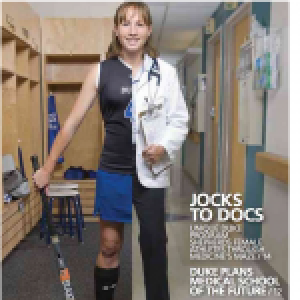
Professor in Orthopaedic Surgery
Professor in the Department of Biomedical Engineering
Affiliate of the Duke Regeneration Center
Home
Our laboratory applies engineering principles to study clinically relevant musculoskeletal system problems. We evaluate in vivo biomechanics using advanced radiographic and MRI techniques, which enables us to investigate soft tissue structure, composition, and function in healthy and diseased states. We develop volumetric models of joints (including the ankle, knee, shoulder, hip, and spine) and soft tissue structures (such as ligaments, tendons, articular cartilage, and intervertebral discs) from 3D MRI scans and use custom software to evaluate mechanical function during in vivo loading (activities of daily living, walking running, strenuous exercise, etc.). We also use optical motion analysis to capture joint-level kinematics during dynamic motions (gait, landing) and simultaneously acquire high-speed biplanar radiographs to evaluate concurrent soft tissue deformations. Combining this data with MRI sequences that non-invasively quantify tissue composition and local and systemic biomarkers of tissue metabolism, we can perform a full-spectrum analysis of joint biomechanical health.
Research
Visit Dr. DeFrate’s Google Scholar page to view our lab’s publications.
Select a tab to learn more about our research group:
People
Learn more about our research group:
Our Team
Alumni
Publications
Selected Publications
- The effects of a 6-month weight loss intervention on physical function and serum biomarkers in older adults with and without osteoarthritis Journal Article Osteoarthritis and Cartilage Open · September 1, 2023
Objective: To examine the effects of a 6-month weight loss intervention on physical function, inflammatory biomarkers, and metabolic biomarkers in those with and without osteoarthritis (OA). Design: 59 individuals ≥60 years old with obesity and a func ...Full text - Automated segmentation and prediction of intervertebral disc morphology and uniaxial deformations from MRI. Journal Article Osteoarthr Cartil Open · September 2023
OBJECTIVE: The measurement of in vivo intervertebral disc (IVD) mechanics may be used to understand the etiology of IVD degeneration and low back pain (LBP). To this end, our lab has developed methods to measure IVD morphology and uniaxial compressive deformity...Full text - The Predicted Position of the Knee Near the Time of ACL Rupture Is Similar Between 2 Commonly Observed Patterns of Bone Bruising on MRI: Response. Journal Article Am J Sports Med · July 2023Full text
- Auto-segmentation of the tibia and femur from knee MR images via deep learning and its application to cartilage strain and recovery. Journal Article J Biomech · March 2023 The ability to efficiently and reproducibly generate subject-specific 3D models of bone and soft tissue is essential to many areas of musculoskeletal research. However, methodologies requiring such models have been mainly limited by lengthy manual segments...Full text
- The Interplay of Biomechanical and Biological Changes Following Meniscus Injury. Journal Article Curr Rheumatol Rep · February 2023
PURPOSE OF REVIEW: Meniscus injury often leads to joint degeneration and post-traumatic osteoarthritis (PTOA) development. Therefore, the purpose of this review is to outline the current understanding of biomechanical and biological repercussions following ...Full text - Elevated In Vivo ACL Strain Is Associated With a Straight Knee in Both the Sagittal and the Coronal Planes. Journal Article Am J Sports Med · February 2023
BACKGROUND: Noncontact anterior cruciate ligament (ACL) injuries typically occur during deceleration movements such as landing or cutting. However, conflicting data have left unclear the kinematic mechanisms leading to these injuries. Quantifying the influx ...Full text - In vivo intervertebral disc mechanical deformation following a treadmill walking "stress test" is inversely related to T1rho relaxation time. Journal Article Osteoarthritis Cartilage · January 2023
OBJECTIVE: To assess the in vivo relationship between the mechanical response of intervertebral discs (IVDs) to dynamic activity and IVD biochemical composition assessed via T1rho relaxation imaging. DESIGN: Eighteen asymptomatic participants with no history ...Full text - The Predicted Position of the Knee Near the Time of ACL Rupture Is Similar Between 2 Commonly Observed Patterns of Bone Bruising on MRI. Journal Article Am J Sports Med · January 2023
BACKGROUND: Bone bruises observed on magnetic resonance imaging (MRI) can provide insight into noncontact anterior cruciate ligament (ACL) injury mechanisms. However, it remains unclear whether the knee position near the time of injury differs...Full text - Predictors of Lumbar Spine Degeneration and Low Back Pain in the Community: The Johnston County Osteoarthritis Project.Journal Article Arthritis Care Res (Hoboken) · October 2022
OBJECTIVE: To determine the incidence and worsening of lumbar spine structure and low back pain (LBP) and whether they are predicted by demographic characteristics or clinical characteristics or appendicular joint osteoarthritis (OA). METHODS: Paired basel ...Full text - Use of a Novel Multimodal Imaging Technique to Model In Vivo Quadriceps Force and ACL Strain During Dynamic Activity. Journal Article Am J Sports Med · August 2022BACKGROUND: Quadriceps loading of the anterior cruciate ligament (ACL) may play a role in the noncontact mechanism of ACL injury. Musculoskeletal modeling techniques estimate the intrinsic force of the quadriceps acting at the knee joint. PURPO ...Full text
- In vivo fluid transport in human intervertebral discs varies by spinal level and disc region. Journal Article Jor Spine · June 2022
BACKGROUND: The lumbar discs are large, dense tissues that are primarily avascular, and cells residing in the central region of the disc are up to 6-8 mm from the nearest blood vessel in adults. To maintain homeostasis, disc cells rely on nutrient transport ...Full text - Design and validation of a semi-automatic bone segmentation algorithm from MRI to improve research efficiency. Journal Article Sci Rep · May 12, 2022Segmentation of medical images into different tissue types is essential for many advancements in orthopaedic research; however, manual segmentation techniques can be time- and cost-prohibitive. The purpose of this work was to develop a semi-automatic segment ...Full text
- Lumbar intervertebral disc diurnal deformations and T2 and T1rho relaxation times vary by spinal level and disc region. Journal Article Eur Spine J · March 2022PURPOSE: Magnetic resonance imaging (MRI) is routinely used to evaluate spine pathology; however, standard imaging findings weakly correlate to low back pain. Abnormal disc mechanical function is implicated as a cause of back pain but is not assessed using ...Full text
- Obesity impacts the mechanical response and biochemical composition of patellofemoral cartilage: An in vivo, MRI-based investigation. Journal Article J Biomech · March 2022 Obesity is a primary risk factor for osteoarthritis. While previous work has addressed relationships between in vivo cartilage mechanics, composition, and obesity in the tibiofemoral joint, there is limited information on these relationships in the patella ...Full text
- Mechanical metrics may show an improved ability to predict osteoarthritis compared to T1rho mapping. Journal Article J Biomech · December 2, 2021Changes in cartilage structure and composition are commonly observed during osteoarthritis (OA) progression. Importantly, quantitative magnetic resonance imaging (MRI) methods, such as T1rho relaxation imaging, can noninvasively provide in vivo meter ...Full text
- Diabetes is associated with a lower minimum moment of inertia among older women: An analysis of 3D reconstructions of clinical CT scans. Journal Article J Biomech · November 9, 2021 Hip fractures significantly burden the aging population, often resulting in reduced mobility, loss of independence, and elevated mortality risk. While fracture risk is generally inversely related to bone mineral density (BMD), people with diabetes...Full text
- Immune cell profiles in synovial fluid after anterior cruciate ligament and meniscus injuries. Journal Article Arthritis Res Ther · November 4, 2021BACKGROUND: Anterior cruciate ligament (ACL) and meniscus tears are common knee injuries. The contributing factors remain unclear despite the high post-traumatic osteoarthritis (PTOA) rate following these injuries. In this study, we characterized the i ...Full text
- Meniscus cell regional phenotypes: Dedifferentiation and reversal by biomaterial embedding. Journal Article J Orthop Res · October 2021 Meniscus injuries commonly cause long-term joint degeneration and disability. Current treatment options are limited, so novel regenerative therapies or tissue engineering strategies are urgently needed. The development of new therapies is ...Full text
- Increasing BMI increases lumbar intervertebral disc deformation following a treadmill walking stress test. Journal Article Journal of Biomechanics · May 2021
High body mass index (BMI) and obesity have been implicated as risk factors for lumbar degenerative disc disease and low back pain. Despite this, there is limited in vivo data to quantify how obesity influences the mechanical function of intervertebral dis ...Full text - Patellar Tendon Orientation and Strain Are Predictors of ACL Strain In Vivo During a Single-Leg Jump. Journal Article Orthop J Sports Med · March 2021
BACKGROUND: Little in vivo data describe the relationships between patellar tendon orientation, patellar tendon strain, and anterior cruciate ligament (ACL) strain during dynamic activities. Quantifying how the quadriceps load the ACL via the ...Full text
Research Opportunities
If you want to join our research team, please contact Dr. Louis E. DeFrate, ScD, lou.defrate@duke.edu
RESEARCH TECHNICIAN II
Requisition Number: 174008
Job Listing: https://careers.duke.edu/job-invite/174008/
Date: January 24, 2022
Location: Durham, NC, US, 27710
Personnel Area: MEDICAL CENTER, School of Medicine:
Perform various complex technical duties involved in conducting physical, chemical, biological, and other research laboratory tests, experiments, and determinations to obtain data for research purposes; compile, analyze, document, and draw tentative conclusions from experimental results. Confer with the principal investigator to review work assignments and develop plans for research experiments; make minor modifications to existing laboratory procedures and techniques to meet the needs of the equipment as required. Review laboratory methods manual, scientific journals, abstracts, and other literature for information applicable to research experiments.
Determine and set up instruments, materials, and apparatus and operate laboratory equipment required for specific tests. Obtain, prepare, mount, and stain tissue, blood, and other substances for microscopic examination and flow cytometry. Run ELISA assays. Prepare culture media, chemicals, reagents, and solutions. Maintain sufficient inventory of material, supplies, and equipment for performing duties; clean and maintain laboratory equipment. Review work of lower-level laboratory personnel within designated areas and assist in training new personnel. Perform other related duties incidental to the work described herein.
News and Events
2022
March 2022
Congratulations to Krystal Tamayo for publishing her work called “Obesity Impacts the Mechanical Response and Biochemical Composition of Patellofemoral Cartilage: An in vivo, MRI-based Investigation” in the Journal of Biomechanics. Co-authors include Lauren Heckelman, Chuck Spritzer, Lou DeFrate, and Amber Collins. You can read the paper here.
January 2022
Congratulations to Lauren Heckelman, PhD for being honored with the Graduate School’s Dean’s Award for Excellence in Teaching! This award celebrates graduate students who best exemplify the characteristics of effective college teaching as they prepare for lives of service, leadership, and teaching. You can read more about this honor here.
John Martin, PhD, recently published a new article entitled “Lumbar intervertebral disc diurnal deformations and T2 and T1rho relaxation times vary by spinal level and disc region” in the European Spine Journal. Co-authors include Alex Oldweiler, Andrzej Kosinski, Chuck Spritzer, Brian Soher, Melissa Erickson, Adam Goode, and Lou DeFrate. You can access the article here.
2021
December 2021
Congratulations to Lauren Heckelman, PhD for defending her dissertation entitled “Multimodal Musculoskeletal Imaging Techniques to Non-Invasively Assess In Vivo Soft and Hard Tissue Biomechanics” on December 9, 2021. Way to go, Lauren!
Congratulations to Hattie Cutcliffe, PhD for publishing her work “Mechanical metrics may show improved ability to predict osteoarthritis compared to T1rho mapping” in the Journal of Biomechanics. Co-authors include Pavan Kottamasu, Amy McNulty, Adam Goode, Chuck Spritzer, and Lou DeFrate. You can read the paper here.
November 2021
Congratulations to Sophia Kim-Wang, PhD, for publishing her work “Immune cell profiles in synovial fluid after anterior cruciate ligament and meniscus injuries” in Arthritis Research & Therapy. Co-authors include Abigail Holt, Alyssa McGowan, Stephanie Danyluk, Adam Goode, Brian Lau, Alison Toth, Jocelyn Wittstein, Lou DeFrate, John Yi, and Amy McNulty. You can read the paper here.
Lauren Heckelman recently published a new article entitled “Diabetes is associated with a lower minimum moment of inertia among older women: An analysis of 3D reconstructions of clinical CT scans” in the Journal of Biomechanics. Co-authors include Ben Wesorick, Lou DeFrate, and Richard Lee. You can access the article here.
July 2021
Congratulations to our newest PhD candidate, James Coppock, for passing his preliminary exam! Way to go, James!
June 2021
Congratulations to Sophia Kim-Wang, PhD for successfully defending her dissertation on Wednesday, June 9. She will now complete her medical education at the Duke University School of Medicine en route to an MD-PhD. Best of luck, Sophia!
May 2021
Congratulations to James Coppock for publishing his work “Increasing BMI increases lumbar intervertebral disc deformation following a treadmill walking stress test” in the Journal of Biomechanics. Co-authors include Stephanie Danyluk, Zoë Englander, Chuck Spritzer, Adam Goode, and Lou DeFrate. You can read the paper here.
Congratulations to our very own Adam Goode, PT, DPT, PhD, and Lou DeFrate, ScD, for publishing an article entitled “Predictors of Lumbar Spine Degeneration and Low Back Pain in the Community: The Johnston County Osteoarthritis Project” in Arthritis Care & Research. You can read the article here.
March 2021
Zoë Englander, PhD, recently published a new article entitled “Patellar Tendon Orientation and Strain Are Predictors of ACL Strain In Vivo During a Single-Leg Jump” in the Orthopaedic Journal of Sports Medicine. Co-authors include Brian Lau, Jocelyn Wittstein, Adam Goode, and Lou DeFrate. You can access the article here. Congrats, Zoë!
February 2021
Bryan Crook recently published a new article entitled “Effect of walking on in vivo tibiofemoral cartilage strain in ACL-deficient versus intact knees” in the Journal of Biomechanics. Co-authors include Amber Collins, Nimit Lad, Chuck Spritzer, Jocelyn Wittstein, and Lou DeFrate. You can access the article here. Congrats, Bryan!
January 2021
Congratulations to Sophia Kim-Wang for publishing her work called “Distribution of Bone Contusion Patterns in Acute Noncontact Anterior Cruciate Ligament–Torn Knees” in the American Journal of Sports Medicine. Co-authors include Melissa Scribani, Michael Whiteside, Lou DeFrate, Tally Lassiter, and Jocelyn Wittstein. You can read the paper here.
Amber Collins, PhD, recently published a new article entitled “Obesity alters the collagen organization and mechanical properties of murine cartilage” in Scientific Reports. Co-authors include Guoli Hu, Hunter Newman, Michael Reinsvold, Monique Goldsmith, Jack Twomey-Kozak, Holly Leddy, Deepika Sharma, Leyao Shen, Lou DeFrate, and Courtney Karner. You can access the article here.



































































